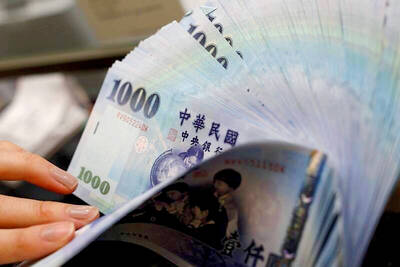The central bank might consider cutting interest rates this quarter if data due on Friday next week show that GDP growth was lower than 3 percent in the first half, economists said yesterday.
The Cabinet on Wednesday instructed the National Development Council to recommend measures to boost exports, which contracted 7.1 percent in the first six months, worse than the 6.95 percent fall the statistics agency projected in May.
The central bank was not a participant in the Cabinet’s discussions, but it might decide to step in and lower interest rates to help stimulate business activity, National Central University economics professor Hsu Chih-chiang (徐之強) said by telephone.
Low borrowing costs would encourage firms to increase the scope of their operations on credit and the negative consumer price index (CPI) reading also lends support to the case for monetary easing, Hsu said.
As of last month, the inflationary gauge had declined an average of 0.65 percent, dragged down by cheaper fuel prices, the Directorate-General of Budget, Accounting and Statistics said.
The agency is due to publish second-quarter GDP data on Friday next week. The figures showed a 3.37 percent increase in the first quarter.
“Poor exports raise alarms if they are not caused by declines in the price of crude,” Hsu said.
The Ministry of Finance has predicted a continued downturn in export data this quarter due to a high base in July and August last year.
Taiwan Semiconductor Manufacturing Co (TSMC, 台積電), the world’s largest contract chipmaker, last week gave a conservative guidance for business going forward, as inventory adjustments linger for its clients in emerging markets.
Against this backdrop, the central bank might cut interest rates by 12.5 basis points this and next quarter, HSBC Hong Kong-based economist John Zhu (朱日平) said.
The British banking group expects Taiwan’s exports to soften in coming months after export orders in May dropped 5.9 percent year-on-year — the fastest pace of decline in two years.
A strong New Taiwan dollar is adding to the challenges, with a 10 percent appreciation in its real effective exchange value this year, whereas central banks in the region have loosened their monetary policy, Zhu said.
Taiwan’s dependence on exports makes the economy susceptible to global cyclical volatility, and the government could shift the focus to domestic demand in a bid to revive the economy, Hsu said.
To that end, the government could increase investment by asking different agencies and state enterprises to upgrade their capital equipment, Zhu said.
For example, Taiwan Power Co (Taipower, 台電) could facilitate the installment of smart meters and smart grids nationwide, Hsu said.

Merida Industry Co (美利達) has seen signs of recovery in the US and European markets this year, as customers are gradually depleting their inventories, the bicycle maker told shareholders yesterday. Given robust growth in new orders at its Taiwanese factory, coupled with its subsidiaries’ improving performance, Merida said it remains confident about the bicycle market’s prospects and expects steady growth in its core business this year. CAUTION ON CHINA However, the company must handle the Chinese market with great caution, as sales of road bikes there have declined significantly, affecting its revenue and profitability, Merida said in a statement, adding that it would

MARKET LEADERSHIP: Investors are flocking to Nvidia, drawn by the company’s long-term fundamntals, dominant position in the AI sector, and pricing and margin power Two years after Nvidia Corp made history by becoming the first chipmaker to achieve a US$1 trillion market capitalization, an even more remarkable milestone is within its grasp: becoming the first company to reach US$4 trillion. After the emergence of China’s DeepSeek (深度求索) sent the stock plunging earlier this year and stoked concerns that outlays on artificial intelligence (AI) infrastructure were set to slow, Nvidia shares have rallied back to a record. The company’s biggest customers remain full steam ahead on spending, much of which is flowing to its computing systems. Microsoft Corp, Meta Platforms Inc, Amazon.com Inc and Alphabet Inc are

RISING: Strong exports, and life insurance companies’ efforts to manage currency risks indicates the NT dollar would eventually pass the 29 level, an expert said The New Taiwan dollar yesterday rallied to its strongest in three years amid inflows to the nation’s stock market and broad-based weakness in the US dollar. Exporter sales of the US currency and a repatriation of funds from local asset managers also played a role, said two traders, who asked not to be identified as they were not authorized to speak publicly. State-owned banks were seen buying the greenback yesterday, but only at a moderate scale, the traders said. The local currency gained 0.77 percent, outperforming almost all of its Asian peers, to close at NT$29.165 per US dollar in Taipei trading yesterday. The

The US overtaking China as Taiwan’s top export destination could boost industrial development and wage growth, given the US is a high-income economy, an economist said yesterday. However, Taiwan still needs to diversify its export markets due to the unpredictability of US President Donald Trump’s administration, said Chiou Jiunn-rong (邱俊榮), an economics professor at National Central University. Taiwan’s exports soared to a record US$51.74 billion last month, driven by strong demand for artificial intelligence (AI) products and continued orders, with information and communication technology (ICT) and audio/video products leading all sectors. The US reclaimed its position as Taiwan’s top export market, accounting for